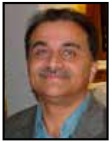Eid al-Adha Highlights from the Sacramento Area
By Ras H. Siddiqui

Some of the first South Asians to arrive in the American West came and settled in central California in the very early 1900’s. They came here from what was then British India, mainly from the Punjab area, the largest numbers being Sikhs followed by Muslims and a small number of Hindus. Many married into the local Mexican community and their descendants remain, but their numbers are now dwarfed by the immigrants who arrived in California after 1965 when America opened its doors to a wider source of immigration. Sacramento has now become home to many of them.
To continue with the Muslim presence today, this region now has over 30 Mosques, and more are being added every year. One can notice the increasing numbers in the area, especially with the prayer attendance during the two Eids. This Eid al-Adha or Bakra Eid as we often refer to it, was an opportunity to witness the diverse followers of Islam in California’s capital city. This writer could only visit three venues which were chosen for different reasons on Friday June 6, 2025, when all area Mosques celebrated. This Eid occasion marks amongst other things the culmination of the Hajj pilgrimage, one of the pillars of our faith.
The first stop was the Muslim Community of Folsom (MCF) where Eid prayers were already underway at their new facility for the very first time. Located at 104 Woodmere Road in Folsom, this approximately 85,000 square feet building with over 7 acres of land is over 4 times the size of the MCF’s old facility on S. Lexington Drive. MCF plans are bold, futuristic and ambitious, as the Sacramento region may be getting its first full time Muslim Kindergarten to High School educational facility here. This address is near the picturesque Lake Natoma on the American River and is quite impressive. With a 13-million-dollar budget and a vision to put the Muslim community on the local high school educational map, MCF and FEA need to be commended. History will be made here (Insha’Allah). The open-air prayers that were held were very well attended. Unfortunately, I could not stay for post-prayer activities but hope to return soon.
The second stop of the day was the historic Downtown Sacramento V Street Muslim Mosque, the oldest Islamic place of worship in the American West. Established in the 1946–1947-timeframe, its inception got tied to history and the partition of British India when the two countries of India and Pakistan were created in 1947. Most of its founders also became “Pakistanis” then and it even once acquired the nickname of “Pakistani Mosque.” I arrived a bit early for the second prayer shift scheduled for 10:00 AM and saw very few people inside but the place filled up fast and the Mosque soon overflowed with worshippers with some praying in the outside courtyard. Leading the prayers, Imam Qasmi delivered an inspiring sermon during which he emphasized the necessity of religious practice in our homes. The Imam also prayed for peace. Booths outside also served pizza, samosas and freshly squeezed sugarcane juice. I picked up a spicy pizza which came with a plate of sweet Jalebis (a real East-West combination) and a glass of juice. This visit was a real trip down memory lane.
The last stop was the Sacramento Area League of Associated Muslims or SALAM where a post-prayer Eid festival was going on. There was plenty of food and dessert available for sale. People originating from Morocco to Turkey, Afghanistan and Pakistan, the diversity of the attendees really stood out here. SALAM has been around for about three decades now and it was great to meet many friends here including founder Dr Metwalli Amer. Available for sale, the Moroccan cookies and the Palestinian Knafeh looked divine. Kids were also getting cotton candy amongst other goodies. It was great to be a part of this festive occasion at least for a short while.
In conclusion, this brief Eid al-Adha report from Sacramento has covered the future, past and obviously the present via three Mosques in the region. And there are many more places to say “Eid Mubarak” from in this part of California, as the community continues to thrive in the region.

